Using Microsimulation to Evaluate Safety and Operational Implications of Newer Roundabout Layouts for European Road Networks
Abstract
:1. Introduction
Description of Standard and Alternative Roundabouts Evaluated
2. Methodology and Evaluation Approach
2.1. Microsimulation Inputs
2.2. Calibration
- -
- Look ahead distance: maximum of 105 m instead of the default value equal to 250 m;
- -
- Look back distance: set to 30 m longer than the default value equal to 250 m;
- -
- Temporary lack of attention: duration 1 s; probability 8%;
- -
- Flagging smooth close-up behavior;
- -
- Average standstill distance: set value equal to 5.00 instead of the default value equal to 2.00;
- -
- Additive part of safety distance: set value equal to 3.6 instead of the default value equal to 2.00;
- -
- Multiple of safety distance: set value equal to 2.00 instead of the default value equal to 3.00.
3. Results
3.1. Operational Performance Measures
3.2. Safety Performance Measures
- -
- The First V and Second V MinTTC value, i.e., the speed of the first and second vehicles at MinTTC, for entry flows of 0.8 V/C (absolute and normalized per 1000 vehicles) and for 2200 veh/h;
- -
- The estimated conflicts from SSAM. This is done for entry flows of 0.8 V/C (absolute and normalized per 1000 vehicles) and for 2200 veh/h;
- -
- Estimated crashes based on applying estimated conflicts (for entry flows of 0.8 V/C and for 2200 veh/h) in crash-conflict models;
4. Summary and Further Research
Supplementary Materials
Supplementary File 1Author Contributions
Conflicts of Interest
References
- Tollazzi, T. Alternative Types of Roundabouts; Springer: New York, NY, USA, 2015. [Google Scholar]
- Tollazzi, T.; Mauro, R.; Guerrieri, M.; Renčelj, M. Comparative Analysis of Four New Alternative Types of Roundabouts: “Turbo”, “Flower”, “Target” and “Four-Flyover” Roundabout. Period. Polytech. Civ. Eng. 2016, 60, 51–60. [Google Scholar] [CrossRef]
- Higle, J.L.; Witowski, J.M. Bayesian Identification of Hazardous Locations Transportation Research Record; TRB; National Research Council: Washington, DC, USA, 1988; pp. 24–31. [Google Scholar]
- Giuffre, O.; Grana, A.; Giuffre, T.; Marino, S.; Marino, R. Flower roundabouts and double-lane roundabouts: A comparative performance analysis. Arch. Civ. Eng. 2014, 60, 349–365. [Google Scholar] [CrossRef]
- Tollazzi, T.; Jovanovic, G.; Rencelj, M. New type of roundabout: Dual one-lane roundabouts on two levels with right-hand turning bypasses—‘‘Target roundabout’’. Promet-Traffic Transp. 2013, 25, 475–481. [Google Scholar] [CrossRef]
- Tollazzi, T.; Tesoriere, G.; Guerrieri, M.; Campisi, T. Environmental, functional and economic criteria for comparing “target roundabouts” with one or two-level roundabout intersections. Transp. Res. Part D 2015, 34, 330–344. [Google Scholar] [CrossRef]
- Archer, J.; Kosonen, I. The Potential of Micro-Simulation Modelling in Relation to Traffic Safety Assessment. In Proceedings of the ESS Conference 2000, Hamburg, Germany, 28–30 September 2000. [Google Scholar]
- VISSIM 5.30 User Manual—PTV Planug Transport Verkehr AG; Manufacture: Karlsruhe, Germany, 2011; Available online: https://www.et.byu.edu/ msaito/CE662MS /Labs/VISSIM_530_e.pdf (assessed on 12 November 2017).
- Gettman, D.; Pu, L.; Sayed, T.; Shelby, S. Surrogate Safety Assessment Model and Validation: Final Report; Report No. FHWA-HRT-08-051; Turner-Fairbank Highway Research Center: McLean, VA, USA; Federal Highway Administration: Washington, DC, USA, June 2008.
- Sayed, T.; Zein, S. Traffic conflict standards for intersections. Transp. Plan. Technol. 1999, 22, 309–323. [Google Scholar] [CrossRef]
- Erfan, A. Investigation of Automated Vehicle e Ects on Driver’s Behavior and Tra c Performance; Linköpings Universitet: Linköping, Sweden, March 2016. [Google Scholar]
- Hagring, O. A further generalization of tanner’s formula. Transp. Res. Part B Methodol. 1998, 32, 423–429. [Google Scholar] [CrossRef]
- Hagring, O. Derivation of Capacity Equation for Roundabout Entry with Mixed Circulating and Exiting Flows. Transp. Res. Rec. J. Transp. Res. Board 2000, 1, 91–99. [Google Scholar] [CrossRef]
- Giuffrè, O.; Granà, A.; Tumminello, M.L. Exploring the uncertainty in capacity estimation at roundabouts. Eur. Transp. Res. Rev. 2017, 9, 18. [Google Scholar] [CrossRef]
- Feldman, O. The GEH measure and quality of the highway assignment models. In Proceedings of the European Transport Conference, Glasgow, UK, 8–10 October 2012. [Google Scholar]
- Shahdah, U.E. Integrating Observational and Microscopic Simulation Model for Traffic Safety Analysis. Master’s Thesis, University of Waterloo, Waterloo, ON, Canada, 2014. [Google Scholar]
- Hyden, C. The Development of a Method for Traffic Safety Evaluation: The Swedish Traffic Conflicts Technique; University of Lund, Lund Institute of Technology Department of Traffic Planning and Engineering: Scania, Sweden, 1987. [Google Scholar]
- Shelby, S.G. Delta-V as a Measure of Traffic Conflict Severity. In Proceedings of the 90th Annual Meeting of the Transportation Research Board Compendium of Papers, Washington, DC, USA, 23–27 January 2011. [Google Scholar]
- Chin, H.C.; Quek, S.T. Measurement of Traffic Conflicts. Saf. Sci. 1997, 26, 169–185. [Google Scholar] [CrossRef]
- Souleyrette, R.; Hochstein, J. Development of a Conflict Analysis Methodology Using SSAM; Final Report; Center for Transportation Research and Education, Iowa State University: Ames, IA, USA, August 2012. [Google Scholar]
- Saulino, G.; Persaud, B.; Bassani, M. Calibration and application of crash prediction models for safety assessment of roundabouts based on simulated conflicts. In Proceedings of the 94th Transportation Research Board (TRB) Annual Meeting, Washington, DC, USA, 11–15 January 2015. [Google Scholar]

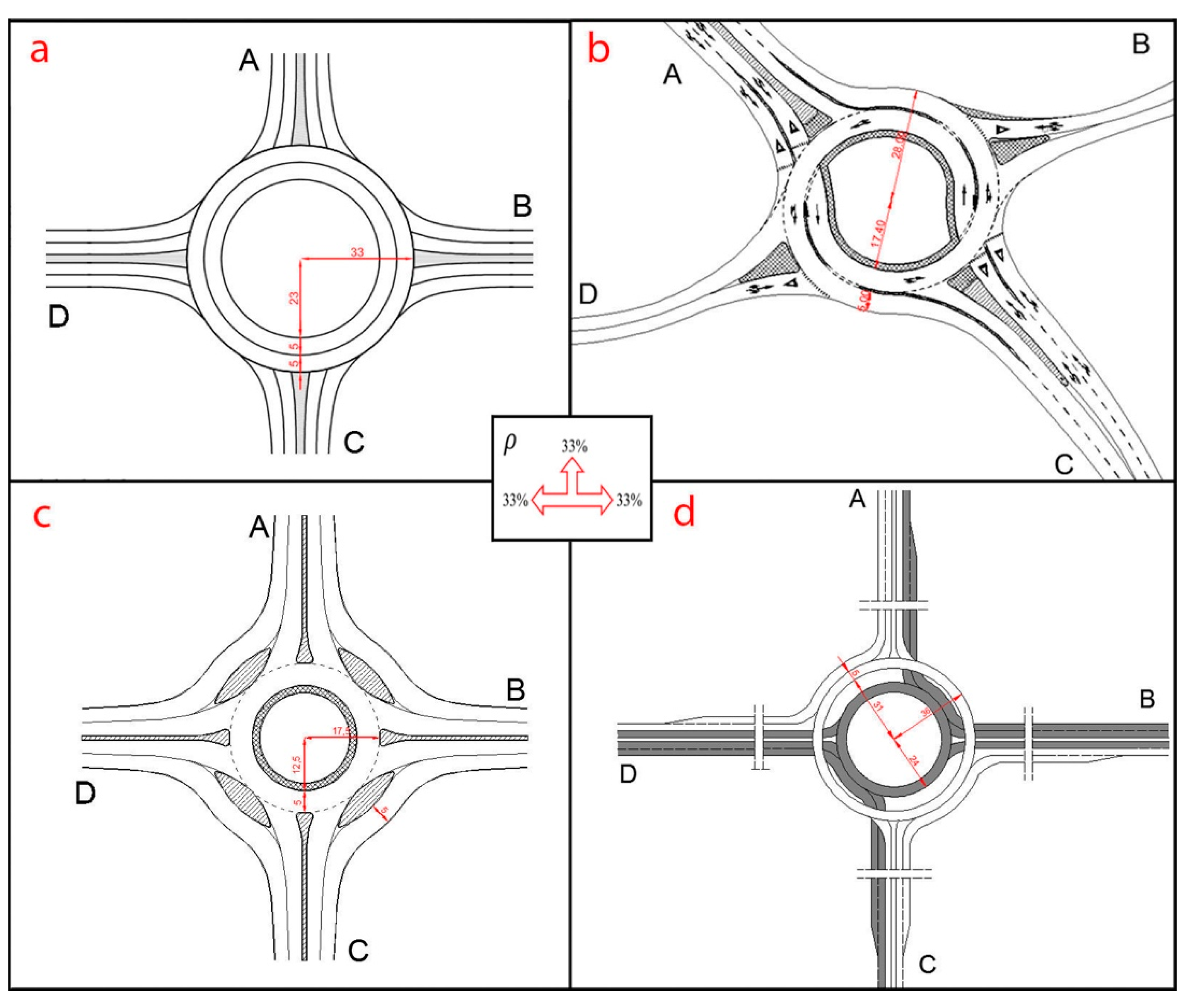
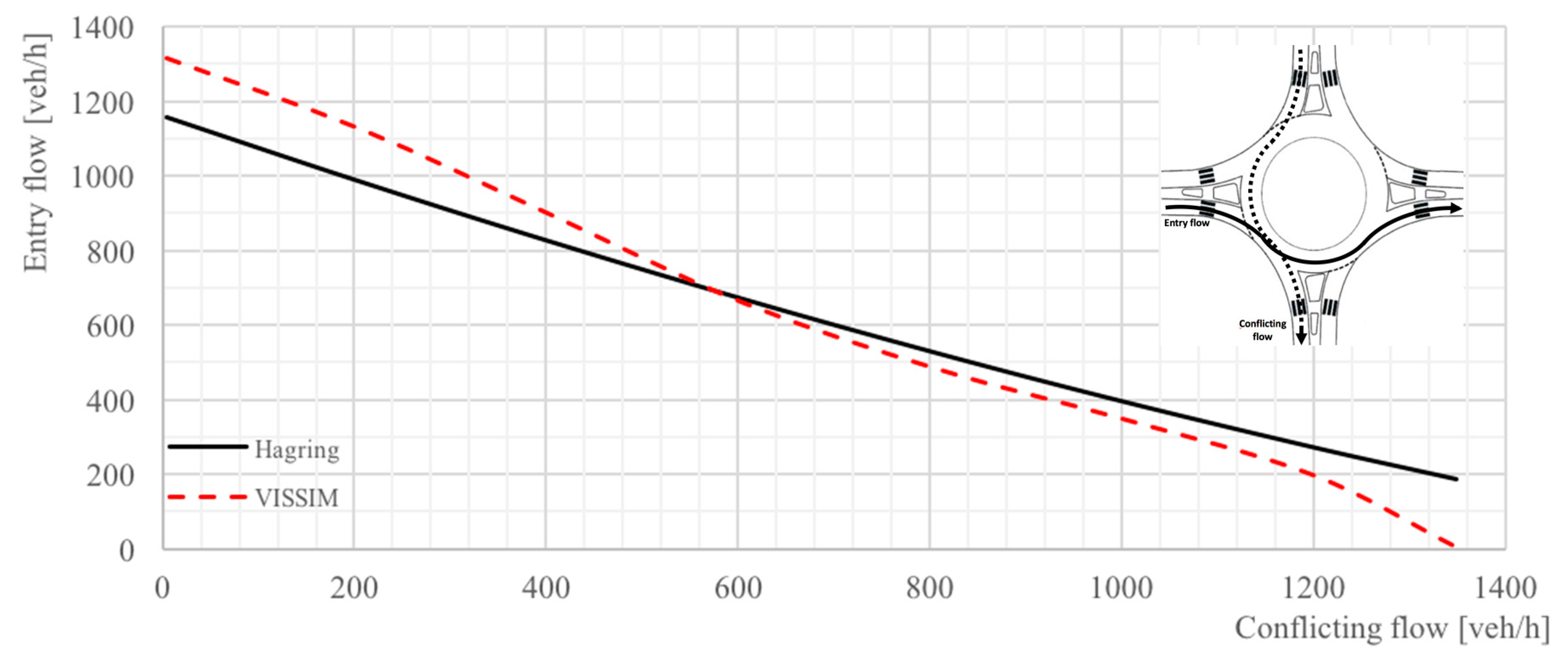


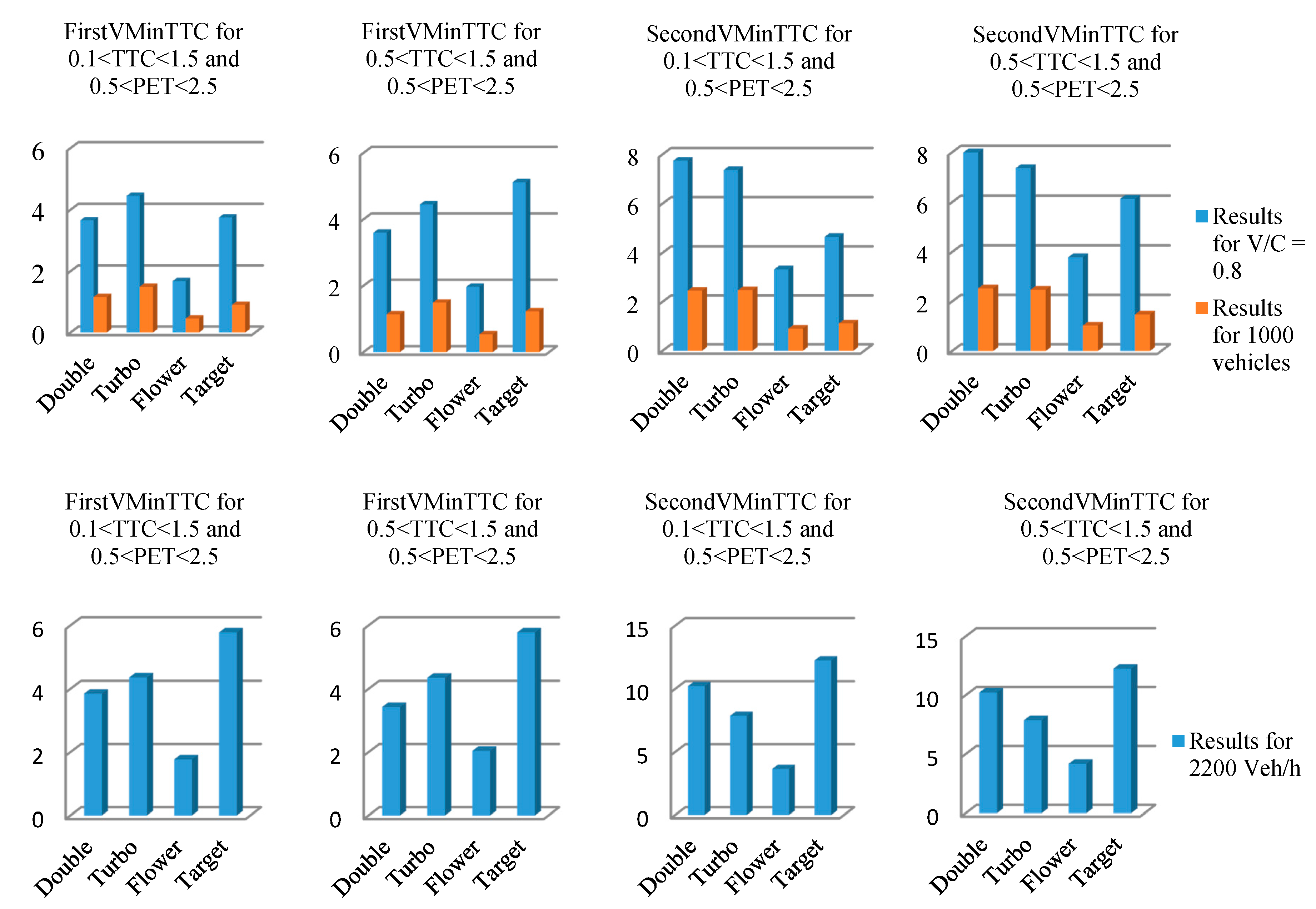

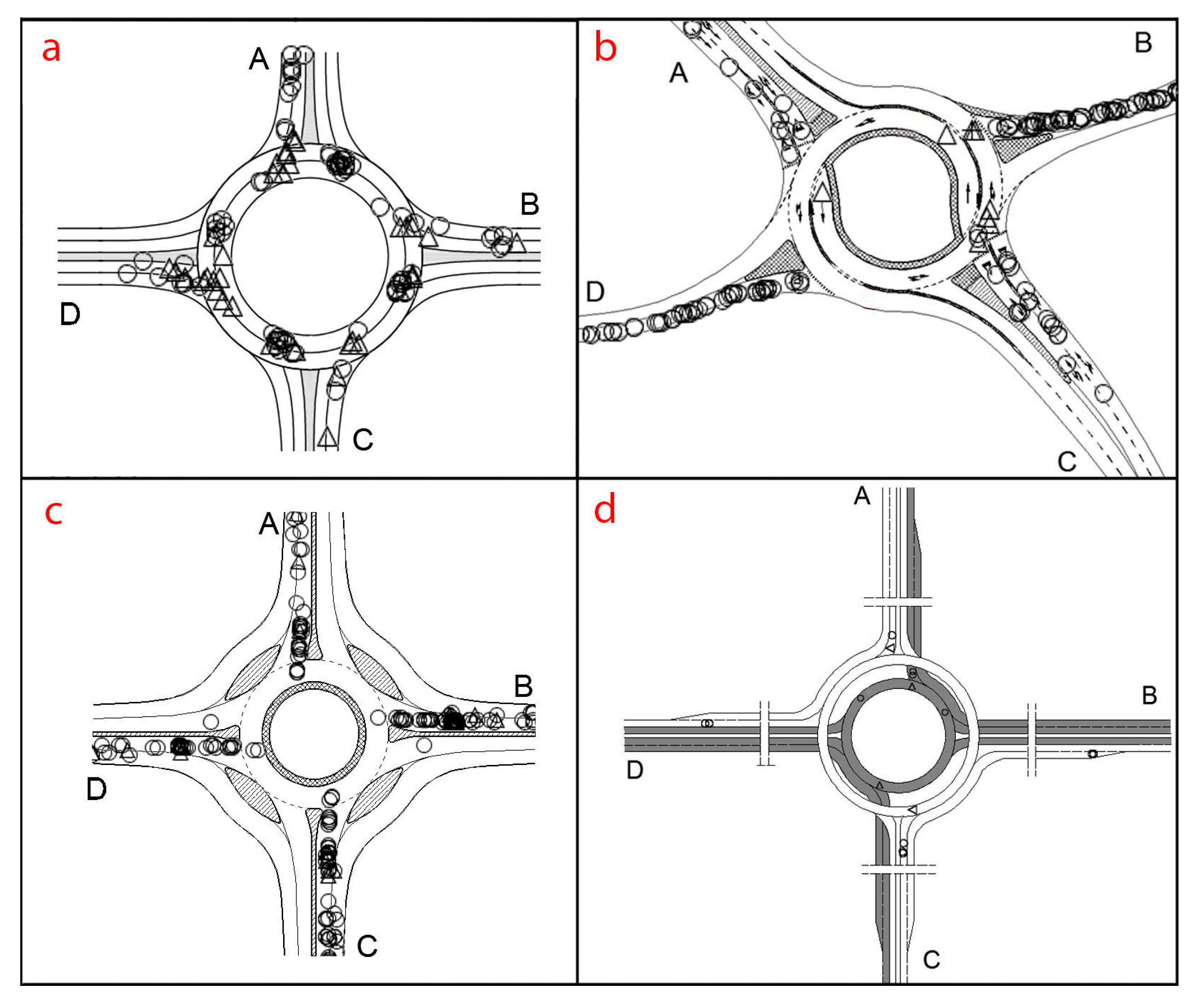
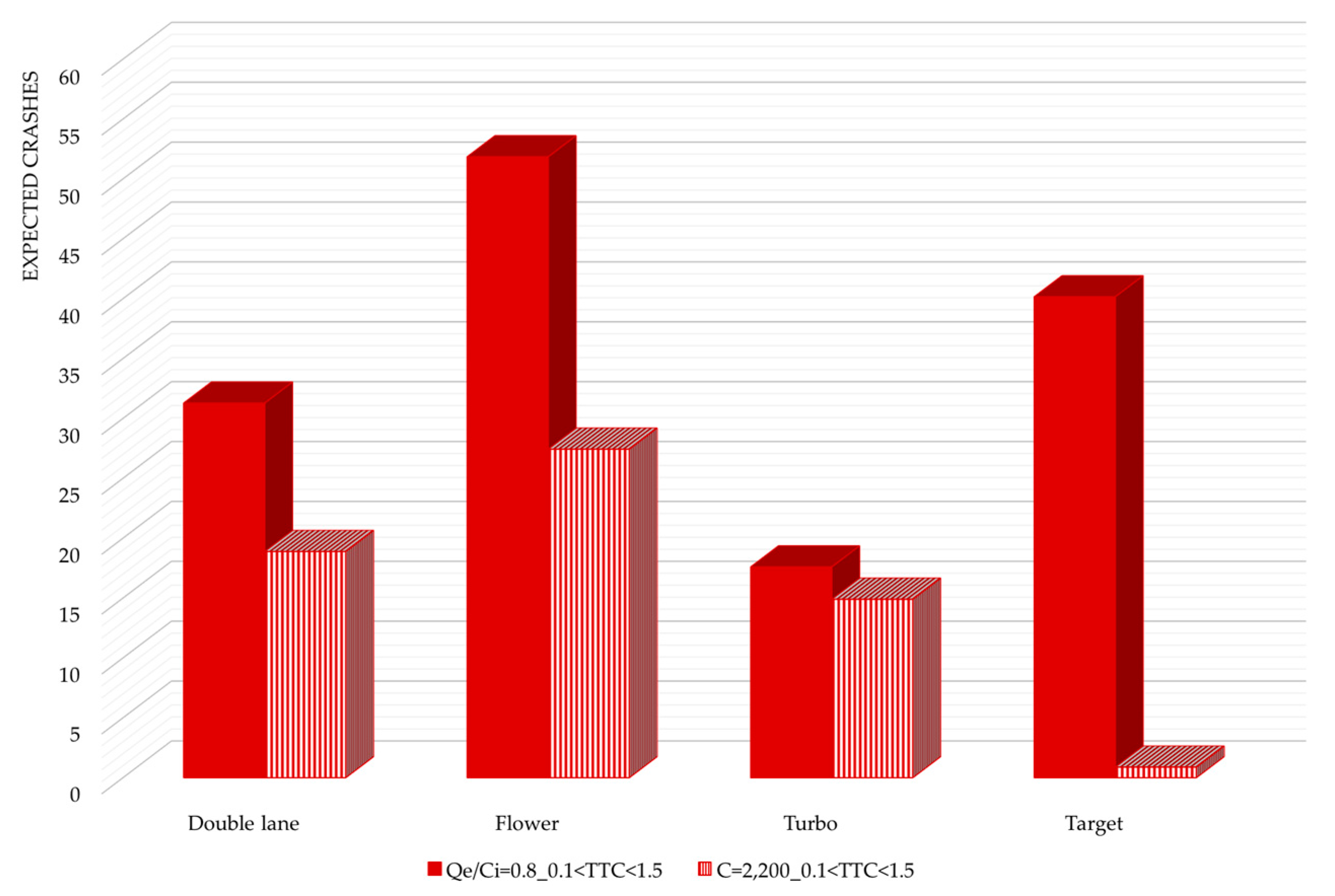
| Roundabout Type | N° of Lanes | Capacity (veh/h) | Outer Diameter (m) | ||
|---|---|---|---|---|---|
| Range | Effective | Range | Effective | ||
| Double lane | 2 | 200–4000 | 3160 | 40–70 | 66 |
| Turbo | 2 | 200–4600 | 2980 | 40–70 | 56 |
| Flower | 2 | 200–5500 | 3680 | 4–70 | 55 |
| Target | 2 | 280–6500 | 4400 | >70 | 72 |
| GEHi | GEH | Interpretation |
|---|---|---|
| GEHi < 5 | GEH > 85% | Acceptable value |
| 5 < GEHi < 10 | 85% < GEH < 70% | Probable error in model development or wrong data |
| GEHi > 10 | GEH < 70% | High probability of error in pattern development or wrong data |
| Roundabout Type | N° of Lanes | GEH (%) | |
|---|---|---|---|
| Right Lane | Left Lane | ||
| Double lane | 2 | 87.5 | 100 |
| Turbo | 2 | 87.5 | 87.5 |
| Flower | 2 | 87.5 | 87.5 |
| Target | 2 | 87.5 | 87.5 |
| Parameter | Equation (3) | Equation (4) | ||
|---|---|---|---|---|
| Estimate | p-Value | Estimate | p-Value | |
| α | −6.287 | <0.0001 | −0.7824 | 0.0378 |
| β1 | 1.3577 | <0.0001 | 0.6828 | 0.0003 |
| β2 | - | - | - | - |
| AIC (Akaike information criterion) | 191.8 | 165.5 | ||
| MPB (Mean prediction bias) | 0.303 | −0.026 | ||
| MAD (Mean absolute deviation) | 6.53 | 1.26 | ||
| MSE (mean squared error) | 156.7 | 3.62 | ||
© 2017 by the authors. Licensee MDPI, Basel, Switzerland. This article is an open access article distributed under the terms and conditions of the Creative Commons Attribution (CC BY) license (http://creativecommons.org/licenses/by/4.0/).
Share and Cite
Giuffrè, T.; Trubia, S.; Canale, A.; Persaud, B. Using Microsimulation to Evaluate Safety and Operational Implications of Newer Roundabout Layouts for European Road Networks. Sustainability 2017, 9, 2084. https://doi.org/10.3390/su9112084
Giuffrè T, Trubia S, Canale A, Persaud B. Using Microsimulation to Evaluate Safety and Operational Implications of Newer Roundabout Layouts for European Road Networks. Sustainability. 2017; 9(11):2084. https://doi.org/10.3390/su9112084
Chicago/Turabian StyleGiuffrè, Tullio, Salvatore Trubia, Antonino Canale, and Bhagwant Persaud. 2017. "Using Microsimulation to Evaluate Safety and Operational Implications of Newer Roundabout Layouts for European Road Networks" Sustainability 9, no. 11: 2084. https://doi.org/10.3390/su9112084






